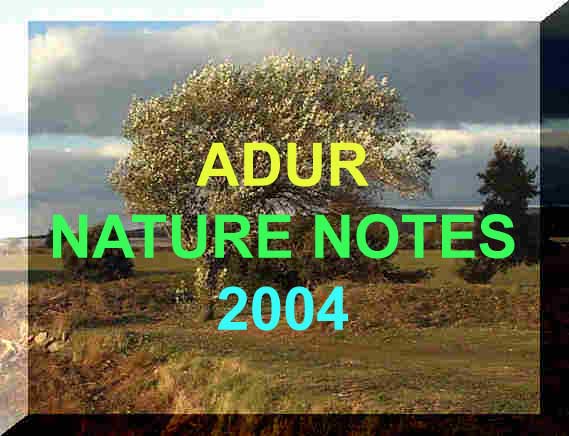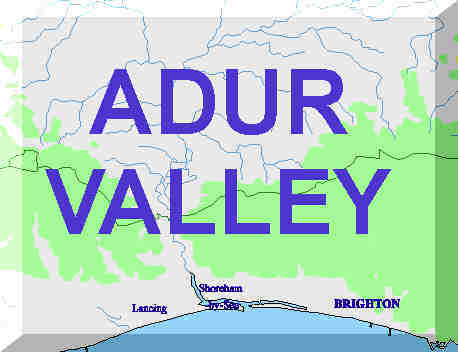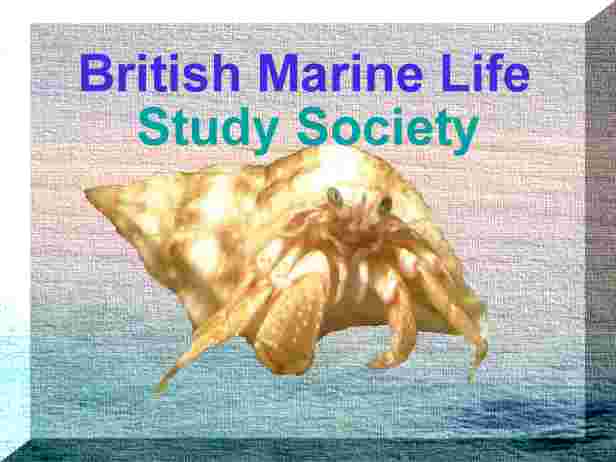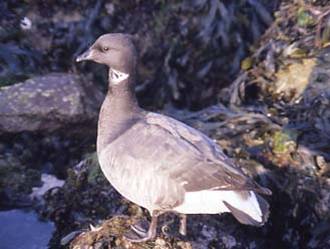WILDLIFE
REPORTS
29
February 2004
A
probable Rough-legged Buzzard
was hanging and occasionally hovering over a ridge between New Erringham
Farm and Thundersbarrow Hill, north of Shoreham in the evening from 5.15
to 6.03 pm (when virtually dark), viewed through
a scope from the minor road
north of Mill Hill at about 1 km distance.
Southwick
Hill and Thundersbarrow 2004The
highlight of bird activity in my south Lancing garden (TQ
186 044) was a brief visit of a male Blackcap,
Sylvia
atricapilla.
A Merlin
(small bird of prey) was seen being chased
by a Black-headed Gull
before it descended into the reed beds near Shoreham
Airport.
Report by Christian Melgar
on the Sussex Birds Yahoo Group
Adur
Levels 2004
27
February 2004
Eight
Magpies congregated on the wasteland
which looks like it was formerly a large garden for the manor house in
Church Street, a stone's throw over into Southwick in the thoroughfare
leading to St. Michael's
Church. Magpies are common enough birds in pairs
and even three together, but eight birds, possibly four pairs, is unusual.
Just
a couple of Goldfinches
were spotted on the roof of a house opposite the easternmost playing fields
in Middle Road, Shoreham. They could be part of a larger chirm unseen,
but the flocks do seem to decrease from about 20 near the autumn equinox
to small flocks of just five by the new year.
Shoreham
Town & Gardens
26
February 2004
McIntyres
Field, Lancing Ring Nature Reserve
(east)
A
Great Spotted Woodpecker at
the top of a large tree was seen briefly before it took flight over the
field to another group of trees on the opposite side.
A flash
of coloured feathers in trees at the top of the meadow was enough to draw
our attention to a Jay
close to a dead tree peppered with holes.
The
fungus Peziza vesiculosa was discovered
on discarded hay at the western woodland margin of McIntyres Field, about
two-thirds of the way up the slope.
Image
Lancing
Nature Notes (by Ray Hamblett)
Adur
Fungi: Fruiting Bodies (Monthly Guide)
The
air temperature dipped just below freezing at minus
0.2° C an hour before sunrise for possibly the first time this winter.
Shoreham
Weather Station
A
Greater Blue-eared Glossy Starling
is spotted by Amanda Solomon (Sussex Wildlife
Trust) in a Southwick garden. This South African
bird probably escaped from an aviary.
25
February 2004
It
the last few days, every single species of the regular birds were seen
in their usual or larger numbers in all habitats in the lower Adur valley,
except I did not catch sight of the brilliant blue wings of a Kingfisher
until today, arrowing through the air over the polluted stream amongst
the Macrocarpa (Monterey Cypress
Trees) row in the Adur Riverbank Industrial
estate (north of the railway line, north of Ropetackle, Shoreham) where
the waste land and cyclepath of the old railway track meets the town.
(TQ 210 053). A
Kingfisher was
seen in the same area last winter.
Adur
Levels 2004
20
February 2004
The
Government have backed a plan to encourage the increase in the
House Sparrow population.
BBC
News Report
In
the Adur area flocks of House Sparrows
seem to be usually in small flocks between 20 and 30 in number. They can
be overlooked but they make such a racket in the scrubbery that is hard
to miss hearing them. It might be worth making a note of where the flocks
are to be found, e.g.
On
the Adur Levels along the cyclepath (old
railway track) south-east of the Toll
Bridge where three flocks up to about 85 birds are regularly seen.
Flitting
around in the shrubbery where they can be clearly seen between Widewater
Lagoon and the shingle beach. There are
more in winter but flocks could be expected all through the year.
In
the towns and gardens the distribution of House
Sparrows is decidedly patchy and there seem
to be more in the partly industrial areas and near the railway tracks.
They are common in Dolphin Road and Corbyn Crescent in Shoreham and in
North
Farm Road, Lancing, but these are just the places where they have been
recorded and there are undoubtably many others.
House
Sparrows have not
been recorded this year in the garden
bird survey in a garden near Buckingham Park.
Adur
Sparrows Page
15
February 2004
Frog
spawn has
been laid in the small garden pond in my south Lancing garden
(TQ 186 044). This
is the first local report. Further
clumps of spawn were laid in subsequent days.
11 February
2004
A
Painted Lady Butterfly
was seen flying at about 8 mph against a light breeze (about 6 mph) from
the north-west near Lancing Beach Green (by the Sailing Club where the
path narrows between the green and Widewater
Lagoon). This butterfly
appeared to be an immigrant, probably
on the long journey from Africa, possibly from France.
Another
Painted Lady Butterfly was
found on the edge of a golf course bunker at Benfield Valley Nature Reserve,
Portslade (TQ 262 079)
where the Blackthorn (=Sloethorn)
was beginning to blossom.
Strong
evidence for Immigration of Painted Ladies
Painted
Ladies Summary 2003-4
10
February 2004
A
migrant Chiffchaff
was reported from Lancing. The exact location
was not given but this small bird inhabits the Lancing
Clump Nature Reserve during the summer months. It is often recognised
by its call.
Hearsay
Report by Betty Bishop
A Little
Grebe (Dabchick)
was ducking and diving on a flooded River
Adur between the Railway
Viaduct and the Toll Bridge.
For the few minutes spell in which I watched, it spent 90% of the time
under the water and it would appear again several metres from the spot
from which it dived.
Adur
Estuary 2004
A Sandwich
Tern flew arrow-like a purposely over
the shallow sea (at high tide) parallel with Southwick beach before disappearing
out of view to the west. Terns are unusual in the winter months.
Adur
Coastal 2004
A
Peregrine Falcon is seen on Shoreham Harbour Power Station chimney
at 8:30 am.
Peregrine
Report by Peter Talbot-Elsden
9
February 2004
I
first spotted the Buzzard (sp) at
about 12.55 pm,
it was soaring over the
Lancing
Manor sports centre and in the general area of Lancing Manor. It soared
around for about five minutes before flying heading west along the southern
ridge of the downs. This is the first Buzzard
I have seen in the Lancing area.
The Sussex
Ornithological Society has the Common Buzzard
down as a rare/scarce
Passage Migrant for Sussex. In the heartlands of Sussex it could be
a rare resident. The Honey Buzzard is a very
scarce Passage Migrant
and the Rough-legged Buzzard is a rare visitor.
SOS
Birds of Prey
The
Shoreham &
District Ornithological Society has only
one previous record (up to 1988) for February and most records are from
over the downs.
 A flutter of orange and the unmistakable patterns of a Painted
Lady Butterfly that flew steadily over
the southern section of Mill Hill. Later,
a second Painted Lady
flew around the copse and settled on the
Beech leaves
still on the tree and several times on the grass. Could these be immigrant
butterflies rather than hibernating adults? Although
it was a clear cloudless day, the temperature only reached 6.5° C.
The winds have been from the north-west for most of this week (last three
days) and south-west for the previous week.
A flutter of orange and the unmistakable patterns of a Painted
Lady Butterfly that flew steadily over
the southern section of Mill Hill. Later,
a second Painted Lady
flew around the copse and settled on the
Beech leaves
still on the tree and several times on the grass. Could these be immigrant
butterflies rather than hibernating adults? Although
it was a clear cloudless day, the temperature only reached 6.5° C.
The winds have been from the north-west for most of this week (last three
days) and south-west for the previous week.
Weather
Graph (February 2004)
The
air temperature has remained above freezing for virtually all of the winter.
(Painted Ladies
may not be able to tolerate freezing conditions?)
Some
lepidopterists tend to favour immigration, although amongst all the naturalists,
the views seem to be about 50/50. I am tending towards the view that some
adult butterflies have been able to survive the mild winter.
NB:
The last date on record for Painted Ladies in the Adur area last year was
10 October 2003.
Research
has found evidence of Painted Ladies
hibernating in Britain.
Immigration
of Lepidoptera
Adur
Butterflies
Adur
Butterfly Flight Times
NB: Further information received
from the south coast of England indicates that these Painted
Lady Butterflies are almost certainly immigrants.
A
further report of a Painted Lady Butterfly
occurred on the northern part of New Monks Farm, Lancing.
A
Stonechat
warbled away south-east of the road bridge over the A27 on the Shoreham
town (Chanctonbury Drive) side.
Stonechat
Report
8
February 2004
Venturing
out from the flower bed undergrowth, the Dunnock
(or Hedge Sparrow) looked very handsome with
its grey breast as it seemed to be attracted to the sunflower seeds that
had fallen from the feeder in the garden of at 40
The Drive (near Buckingham Park), Shoreham-by-Sea,
(TQ 219 063).
This is the first time a Dunnock
has been seen in this garden. I wonder how many female Dunnocks
will be attracted to this male bird?
Six
Greenfinches and a handsome Great
Tit were amongst other birds present.
Adur
Valley Biodiversity "Garden Birds" Self-entry Database (for Shoreham)
7 February
2004
A
single House Martin
was seen flying low up the River Adur this afternoon
at 3:00 pm just
south of the Toll Bridge for five
minutes or so before heading up the Adur Valley. This is an extraordinary
early record for this summer migrant.
Adur
Levels 20044
February 2004
A
Grey Heron
perched on the roof of a semi-detached house
at the southern end of Greenways Crescent
(TQ 266 063)
near the main road in a residential area of
Shoreham, and over a mile (2 km) from its normal wetland
or estuarine haunts. This residential area
contains medium-sized and some large gardens capable of having large ponds.
As
I walked out of the door to do the school run as a butterfly
took off
down
the my front garden in south Lancing (TQ 186
044) carried by the light breeze. It was too
quick to positively identify and in silhouette but seemed pale and may
have been a Painted Lady.
This is the first butterfly of the year. This
the same location from which the last Painted
Lady of 2003
was seen on 10 October 2003.
Butterfly
Flight Times (Adur)
NB:
Painted Lady Butterflies
have subsequently been reported from other parts of Sussex including near
Portslade railway station. The brief interlude of warm weather must have
encouraged hibernating butterflies to emerge. The have no previous records
of hibernating Painted Ladies
surviving the winter on these Nature Notes pages and this is the first
February record.
1
February 2004
Looking
and behaving a Wren
with a dab of golden war paint, I had the my best ever view of a Goldcrest
in the garden of at 40
The Drive (near Buckingham Park), Shoreham-by-Sea,
(TQ 219 063). The first impression is
the slightly different colouring of the wing feathers, the confirmation
the golden strip on the forehead. (This is the colour of the female.) Alas,
although I had a prolonged view, this small bird was disturbed and did
not return to the garden. It is the smallest British bird (a distinction
it shares with the rarer Firecrest)
but this was not the impression I got. It seemed almost the same size as
a Wren, perhaps
even a fraction bigger, and larger than the Long-tailed
Tit.
The
Goldcrest was
seen again on 16 February 2004.
Adur
Town and Gardens 2004
Adur
Valley (Shoreham) Biodiversity "Garden Birds" Self-entry Database













